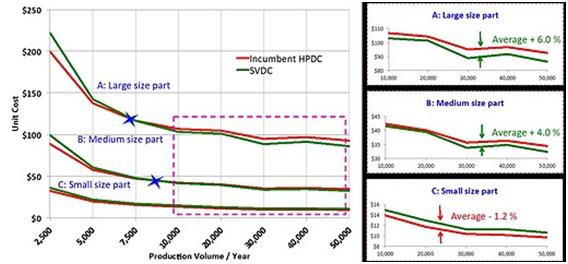According to the SAE website published on January 10, 2018, Gaoling (HPDC) is a traditional casting process suitable for aluminum-magnesium alloys, but it is not without flaws. The main performance is that pores are prone to occur during the process, and the quality is not guaranteed. The application of this process in aerospace. Vacuum low pressure casting (SVDC) avoids this deficiency and is widely recognized in the industry.

The red arrow indicates the fuel port cover of the Boeing 737MAX, which is the main example of vacuum low pressure casting used in the aerospace sector.
With SVDC, designers can design integral thin-walled parts with complex shapes for weight reduction, energy reduction, and cost. Since the conventional process is prone to defects, in order to achieve the required strength, the thickness of the part is often designed as an upper limit, but the thickened part cannot be subjected to subsequent heat treatment, posing a risk to the assembly and machine. The advantage of SVDC is that it can be used for subsequent heat treatment to improve the performance of the casting and to combine individual parts into a single unit. Compared with the monolithic part, the weight of the assembly can be reduced by 20%, the wall thickness is reduced by 40%, and the energy consumption, material use cost, radiation and heat treatment are used to improve the mechanical properties and broaden the scope of use.
Regarding the benefits of SVDC, we use a process-based cost model (PBCM) to evaluate. PBCM is a three interrelated and interdependent model, including technical process model, production operation model and capital accounting model. The basic elements of a technical process model include materials, energy, labor, equipment, scrap, and quality. The key element of the operational model is time, which is critical to determining how technical processes are physically implemented and organized, and how plant managers allocate equipment resources in a cost-effective and easy-to-use manner. In the capital model, the resources in the above model are converted into economic costs. For example, factors of production (such as energy, labor, materials, equipment, etc.) are measured by the purchase price. The key points of these models are based on physical relationships or statistical relationships, such as critical resource requirements such as equipment performance (casting ability, mold clamping force, etc.) and production time, and part performance (size and quality) and process parameters. (temperature, pressure) relationship, and then convert these requirements into special costs.
The PBCM model can compare the material, energy consumption, etc. for a process with different production efficiencies, part sizes and applications, and perform profit and loss analysis.
The following table shows the cost analysis of the flap and the two accessories to assess the cost-effectiveness of the part size. The red line is the unit cost of HPDC, and the green line is the unit cost of SVDC. When the output of the three parts is very low, the unit cost of SVDC is significantly higher than HPDC, but the cost tends to be consistent or even slightly lower than HPDC as the output increases. The point at which the same cost is reached is marked with blue stars in the table. .
For large parts, when the production volume is 7,180 pieces and the unit price is 118.14 US dollars, the cost of the two processes is the same; for medium-sized parts, the production volume is 8,230 pieces, and the unit price is consistent at 45.54 USD. The weight of large, medium and small parts is 22 kg, 5.4 kg and 0.4 kg respectively.

SVDC and HPDC cost analysis chart, it can be seen that the cost of using SVDC for small parts is 1.2% higher than HPDC, and 6% for large parts.
If the annual output of medium and large parts can reach 10,000 pieces, it is very advantageous to use SVDC production, because SVDC can mainly reduce the amount of materials, but the material usage of small parts is originally small, so the advantage of SVDC for small parts is not obvious. . For small parts, however, the cost of using SVDC is only 1.2% higher than HPDC, which can be balanced by pairing with large parts or controlling energy consumption.
In the future, SVDC will help improve product performance, quality, reliability, parts consistency and reduce carbon emissions, making it the technology of choice for most industries, including aerospace.
Washing Machine Motor,Spin Motor Of Aluminium Wire,Washing Machine Motor Shaft,Automatic Washing Machine Spin Motor
WUJIANG JINLONG ELECTRIC APPLIANCE CO., LTD , https://www.jinlongmotor.com